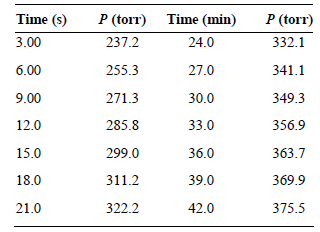The first-order thermal decomposition of chlorocyclohexane is as follows: C 6 H 11 Cl(g) C 6
Question:
The first-order thermal decomposition of chlorocyclohexane is as follows: C6H11Cl(g) → C6H10(g) + HCl(g).
For a constant volume system, the following total pressure was measured as a function of time:

a. Derive the following relationship for a first-order reaction: P(t2) – P(t1) = (P(∞) – P(t0))e-kt1(1 – e-k(t2 – t1)). In this relation, P(t1) and P(t2) are the pressures at two specific times; P(t0) is the initial pressure when the reaction is initiated; P(t∞) is the pressure at the completion of the reaction; and k is the rate constant for the reaction. To derive this relationship, do the following:
i. Given the first-order dependence of the reaction, write down the expression for the pressure of chlorocyclohexane at a specific time t1.
ii. Write the expression for the pressure at another time t2, which is equal to t1 + Δ, where delta is a fixed quantity of time.
iii. Write expressions for P(t∞) − P(t1) and P(t∞) − P(t2).
iv. Subtract the two expressions from part (iii).
b. Using the natural log of the relationship from part (a) and the data provided in the table given earlier in this problem, determine the rate constant for the decomposition of chlorocyclohexane.
Step by Step Answer:






